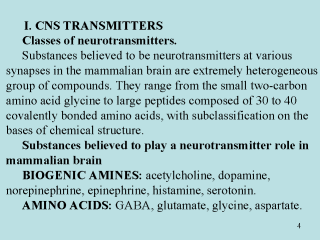| front |1 |2 |3 |4 |5 |6 |7 |8 |9 |10 |11 |12 |13 |14 |15 |16 |17 |18 |19 |20 |21 |22 |23 |24 |25 |26 |27 |28 |review |
 |
NUCLEOTIDES
& NUCLEOSIDES: adenosine, ATP. PEPTIDES: carnosine, thyrotropin-releasing hormone, enkephalins, angiotensin II, cholecystokinin, oxytocin, vasopressin, bradykinin, dynorphin, luteinizing hormone-releasing hormone, substance P, substance K, neurotensin, á -melanocyte stimulating hormone, bombesin, somatostatin, secretin, vasoactive intestinal peptide, B -endorphin, glucagon, calcitonin-gene-related peptide, neuropeptide Y, adrenocorticotropic hormone, corcticotropin-releasing factor, insulin. Neurotransmitters can also be subdivided on the bases of their functional roles in other cells. First, there are the substances that have no other known function in mammalian physiology. These include three of biogenic amines (acetylcholine, norepinephrine and dopamine), one amino acid (GABA) and few of the peptides (e.g. neuropeptide Y, calcitonin-gene-related peptide, and substance P). There is a large second class of substances that function as hormones in other tissues but also serve as neurotransmitters. These include three other biogenic amines (epinephrine, histamine, serotonin) and all the remaining peptides. |